Microstructure Formation and Its Effect on Mechanical Properties for Duplex Stainless Steel 2205 Plasma Arc Welded Joint
Abstract
:1. Introduction
2. Experimental Procedures
2.1. Manufacture of Welded Joints by Plasma Arc Welding
2.2. Microstructure Observation
2.3. Characterization of Mechanical Properties
3. Experimental Results
3.1. Microstructure Analysis
3.2. Mechanical Performance
4. Discussion
4.1. Formation Mechanism of Microstructure
4.2. Correlation between Mechanical Properties and Microstructure
5. Conclusions
- (1)
- Phase equilibrium can be efficiently maintained by using PAW. Of the welded joints, about 40% are ferritic and 60% are austenitic.
- (2)
- The main forms of austenite found in the WM and HAZ are GBA and IGA, with a larger concentration of WA observed there as well. At the joints, grain coarsening and distortion are still evident. While the heat-affected zone and weld strength center exhibit the same process of grain coarsening, this transition zone is distinguished by the switch from an equiaxial to columnar ferrite grain shape.
- (3)
- In terms of mechanical characteristics, the welded joints show more hardness than the parent material. The tensile strength in the transverse direction is comparable to that of the parent material, even if plasticity and toughness have somewhat decreased, whereas the tensile strength in the longitudinal direction has slightly dropped, the elongation of the welded joint was 10% lower than that of the base material. Therefore, in actual engineering applications, any tensile stress exerted in this direction must be kept to a minimum.
Author Contributions
Funding
Data Availability Statement
Conflicts of Interest
Abbreviations
References
- Tóth, T.; Krasnorutskyi, S.; Hensel, J.; Dilger, K. Electron beam welding of 2205 duplex stainless steel using pre-placed nickel-based filler material. Int. J. Press. Vessel. Pip. 2021, 191, 104354. [Google Scholar] [CrossRef]
- Sun, T.; Guo, Y.; Jiang, Y.; Li, J. Effect of Short-Time Aging on the Pitting Corrosion Behavior of a Novel Lean Duplex Stainless Steel 2002. Acta Metall. Sin. (Engl. Lett.) 2019, 32, 755–763. [Google Scholar] [CrossRef]
- Han, J.; Sun, J.; Han, Y.; Liu, H. Hot Workability of the as-Cast 21Cr Economical Duplex Stainless Steel Through Processing Map and Microstructural Studies Using Different Instability Criteria. Acta Metall. Sin. (Engl. Lett.) 2017, 30, 1080–1088. [Google Scholar] [CrossRef]
- Ureñ, A.A.; Otero, E.; Utrilla, M.; Múnez, C. Weldability of a 2205 duplex stainless steel using plasma arc welding. J. Mater. Process. Technol. 2007, 182, 624–631. [Google Scholar] [CrossRef]
- Sadeghian, M.; Shafyei, A. Effect of heat input on microstructure and mechanical properties of dissimilar joints between super duplex stainless steel and high strength low alloy steel. Mater. Des. 2014, 60, 678–684. [Google Scholar] [CrossRef]
- Sato, Y.; Nelson, T.; Sterling, C.; Steel, R.; Pettersson, C.O. Microstructure and mechanical properties of friction stir welded SAF 2507 super duplex stainless steel. Mater. Sci. Eng. A 2005, 397, 376–384. [Google Scholar] [CrossRef]
- Wang, W.; Hu, Y.; Wu, T.; Zhao, D.; Zhao, H. Effect of Rotation Speed on Microstructure and Mechanical Properties of Friction-Stir-Welded 2205 Duplex Stainless Steel. Adv. Mater. Sci. Eng. 2020, 2020, 5176536. [Google Scholar] [CrossRef]
- Ahmed, M.M.Z.; Hajlaoui, K.; Seleman, M.M.E.-S.; Elkady, M.F.; Ataya, S.; Latief, F.H.; Habba, M.I.A. Microstructure and Mechanical Properties of Friction Stir Welded 2205 Duplex Stainless Steel Butt Joints. Materials 2021, 14, 6640. [Google Scholar] [CrossRef]
- Fei, Z.; Pan, Z.; Cuiuri, D.; Li, H.; Van Duin, S.; Yu, Z. Microstructural characterization and mechanical properties of K-TIG welded SAF2205/AISI316L dissimilar joint. J. Manuf. Process. 2019, 45, 340–355. [Google Scholar] [CrossRef]
- Cui, S.; Pang, S.; Pang, D.; Zhang, Z. Influence of Welding Speeds on the Morphology, Mechanical Properties, and Microstructure of 2205 DSS Welded Joint by K-TIG Welding. Materials 2021, 14, 3426. [Google Scholar] [CrossRef]
- Xie, X.-F.; Jiang, W.; Pei, X.; Niu, R.; Li, X.; Dong, Z.; Wan, Y.; Liu, B. Synthetical effect of material inhomogeneity and welding defects on fatigue behavior of 2205 duplex stainless steel cruciform welded Joints: Experiments and Life-prediction model. Int. J. Fatigue 2023, 168, 107472. [Google Scholar] [CrossRef]
- Zhang, Z.; Han, Y.; Lu, X.; Zhang, T.; Bai, Y.; Ma, Q. Effects of N2 content in shielding gas on microstructure and toughness of cold metal transfer and pulse hybrid welded joint for duplex stainless steel. Mater. Sci. Eng. A 2023, 872, 144936. [Google Scholar] [CrossRef]
- Baghdadchi, A.; Hosseini, V.A.; Hurtig, K.; Karlsson, L. Promoting austenite formation in laser welding of duplex stainless steel—Impact of shielding gas and laser reheating. Weld World 2021, 65, 499–511. [Google Scholar] [CrossRef]
- Fu, Z.H.; Yang, B.J.; Shan, M.L.; Li, T.; Zhu, Z.Y.; Ma, C.P.; Zhang, X.; Gou, G.Q.; Wang, Z.R.; Gao, W. Hydrogen embrittlement behavior of SUS301L-MT stainless steel laser-arc hybrid welded joint localized zones. Corros. Sci. 2020, 164, 108337. [Google Scholar] [CrossRef]
- Fang, J. Effects of phase transition temperature and preheating on residual stress in multi-pass & multi-layer laser metal deposition. J. Manuf. Process. 2021, 2021, 68. [Google Scholar]
- Wu, M.; Liu, F.; Pu, J.; Anderson Neil, E.; Li, L.; Liu, D. The Microstructure and Pitting Resistance of Weld Joints of 2205 Duplex Stainless Steel. J. Mater. Eng. Perform. 2017, 26, 11. [Google Scholar] [CrossRef]
- Luo, J.; Dong, Y.; Li, L.; Wang, X. Microstructure of 2205 duplex stainless steel joint in submerged arc welding by post weld heat treatment. J. Manuf. Process. 2014, 16, 144–148. [Google Scholar] [CrossRef]
- Cui, S.; Shi, Y.; Cui, Y.; Zhu, T. The influence of microstructure and chromium nitride precipitations on the mechanical and intergranular corrosion properties of K-TIG weld metals. Constr. Build. Mater. 2019, 210, 71–77. [Google Scholar] [CrossRef]
- Sato, Y.S.; Kokawa, H. Preferential precipitation site of sigma phase in duplex stainless steel weld metal. Scr. Mater. 1999, 40, 659–663. [Google Scholar] [CrossRef]
- Wu, H.C.; Tsay, L.W.; Chen, C. Laser Beam Welding of 2205 Duplex Stainless Steel with Metal Powder Additions. Trans. Iron Steel Inst. Jpn. 2004, 44, 1720–1726. [Google Scholar] [CrossRef]
- Liu, Z.; Cui, S.; Luo, Z.; Zhang, C.; Wang, Z.; Zhang, Y. Plasma arc welding: Process variants and its recent developments of sensing, controlling and modeling. J. Manuf. Process. 2016, 23, 315–327. [Google Scholar] [CrossRef]
- Pramod, R.; Kumar, S.; Shanmugam, N.; Vendan, S. Formability studies on plasma arc welded duplex stainless steel 2205 sheet. Mater. Sci. Eng. Technol. 2020, 51, 163–173. [Google Scholar] [CrossRef]
- UNE-EN ISO 4136-2012; Destructive Tests on Welds in Metallic Materials. Transverse Tensile Test: Brussels, Belgium, 2013.
- Dong, Z.; Xie, X.; Li, J.; Wan, Y. Thickness-Dependent Microstructure and its Effect on Anisotropic Mechanical Properties of Duplex Stainless Steel 2205 Multi-pass Welded Joints. Acta Metall. Sin. (Engl. Lett.) 2023, 36, 1883–1892. [Google Scholar] [CrossRef]
- Fakic, B. Changes of physico-metalic properties of 16mo3 and 13crmo4-5 steels in the tig welding procedure. In Proceedings of the Conference on Mechanical Engineering Technologies and Applications(COMET 2018), Sarajevo, Bosnia and Herzegovina, 27 November 2018; pp. 162–168. [Google Scholar]
- Tanguy, B.; Besson, J.; Piques, R.; Pineau, A. Ductile to brittle transition of an A508 steel characterized by Charpy impact test, part II: Modeling of the Charpy transition curve. Eng. Fract. Mech. 2005, 72, 413–434. [Google Scholar] [CrossRef]
- ASTM E23-12c; Standard Test Methods for Notched Bar Impact Testing of Metallic Materials. ASTM International (ASTM): West Conshohocken, PA, USA, 2012.
- Rossoll, A.; Berdin, C.; Prioul, C. Determination of the Fracture Toughness of a Low Alloy Steel by the Instrumented Charpy Impact Test. Int. J. Fract. 2002, 115, 205–226. [Google Scholar] [CrossRef]
- Ku, J.; Ho, N.; Tjong, S. Properties of electron beam welded SAF 2205 duplex stainless steel. J. Mater. Process. Technol. 1997, 63, 770–775. [Google Scholar] [CrossRef]
- Vijayalakshmi, K.; Muthupandi, V.; Jayachitra, R. Influence of heat treatment on the microstructure, ultrasonic attenuation and hardness of SAF 2205 duplex stainless steel. Mater. Sci. Eng. A 2011, 529, 447–451. [Google Scholar] [CrossRef]
- Calliari, I. Investigation of secondary phase effect on 2205 DSS fracture toughness. Mater. Sci. Technol. 2010, 26, 81–86. [Google Scholar] [CrossRef]
- Ajith, P.; Sathiya, P.; Aravindan, S. Experimental Investigation on Friction Welding of UNS S32205 Duplex Stainless Steel. Acta Metall. Sin. (Engl. Lett.) 2014, 27, 995–1007. [Google Scholar] [CrossRef]
- Gao, S.; Geng, S.; Jiang, P.; Mi, G.; Han, C.; Ren, L. Numerical analysis of the deformation behavior of 2205 duplex stainless steel TIG weld joint based on the microstructure and micro-mechanical properties. Mater. Sci. Eng. A 2021, 815, 141303. [Google Scholar] [CrossRef]
- Bouabdallah, R. Texture, microstructure and anisotropic properties in annealed 2205 duplex stainless steel welds. Mater. Charact. 2011, 62, 9. [Google Scholar]
- Pan, M.; Zhang, X.; Chen, P.; Su, X.; Misra, R. The effect of chemical composition and annealing condition on the microstructure and tensile properties of a resource-saving duplex stainless steel. Mater. Sci. Eng. A 2020, 788, 139540. [Google Scholar] [CrossRef]
- Haghdadi, N.; Cizek, P.; Hodgson, P.; Tari, V.; Beladi, H. Effect of ferrite-to-austenite phase transformation path on the interface crystallographic character distributions in a duplex stainless steel. Acta Mater. 2017, 145, 196–209. [Google Scholar] [CrossRef]
- Freitas, G.; Fonseca, G.; Moreira, L.; Leite, D. Phase transformations of the duplex stainless steel UNS S31803 under non-isothermal conditions. J. Mater. Res. Technol. 2021, 11, 1847–1851. [Google Scholar] [CrossRef]
- Dóra, B.; Simon, F. Unusual spin dynamics in topological insulators. Sci. Rep. 2015, 5, 14844. [Google Scholar] [CrossRef] [PubMed]
- Bolut, M.; Kong, C.Y.; Blackburn, J.; Cashell, K.A.; Hobson, P.R. Yb-fibre Laser Welding of 6 mm Duplex Stainless Steel 2205. Phys. Procedia 2016, 83, 417–425. [Google Scholar] [CrossRef]
- Cui, S.; Pang, S.; Pang, D.; Zhang, Q.; Zhang, Z. Numerical Simulation and Experimental Investigation on 2205 Duplex Stainless Steel K-TIG Welded Joint. Metals 2021, 11, 1323. [Google Scholar] [CrossRef]
- Karimi, A.; Karimipour, A.; Akbari, M.; Razzaghi, M.M.; Ghahderijani, M.J. Investigating the mechanical properties and fusion zone microstructure of dissimilar laser weld joint of duplex 2205 stainless steel and A516 carbon steel. Opt. Laser Technol. 2023, 158, 108875. [Google Scholar] [CrossRef]
- Li, S.; Guo, C.; Hao, L.; Kang, Y.; An, Y. In-situ EBSD study of deformation behavior of 600 MPa grade dual phase steel during uniaxial tensile tests. Mater. Sci. Eng. A 2019, 759, 624–632. [Google Scholar] [CrossRef]
- Gao, Z.; Li, J.; Wang, Y. Analysis of the Deep Drawing Behavior of 2507 Super Duplex Stainless Steel Based on Texture and Microstructure Evolutions. ISIJ Int. 2019, 59, 531–540. [Google Scholar] [CrossRef]
- Jebaraj, A.; Kumar, L.; Deepak, C. Investigations on anisotropy behavior of duplex stainless steel AISI 2205 for optimum weld properties. Procedia Eng. 2017, 173, 883–890. [Google Scholar] [CrossRef]
- SołTysiak, R.; GięTka, T.; SołTysiak, A. The effect of laser welding power on the properties of the joint made of 1.4462 duplex stainless steel. Adv. Mech. Eng. 2018, 10, 168781401775194. [Google Scholar] [CrossRef]
- Tucker, J.; Miller, M.; Young, G. Assessment of thermal embrittlement in duplex stainless steels 2003 and 2205 for nuclear power applications. Acta Mater. 2015, 87, 15–24. [Google Scholar] [CrossRef]
- Chen, T.; Weng, K.; Yang, J. The effect of high-temperature exposure on the microstructural stability and toughness property in a 2205 duplex stainless steel. Mater. Sci. Eng. A 2002, 338, 259–270. [Google Scholar] [CrossRef]
- Momeni, A.; Dehghani, K. Hot working behavior of 2205 austenite–ferrite duplex stainless steel characterized by constitutive equations and processing maps. Mater. Sci. Eng. A 2011, 528, 1448–1454. [Google Scholar] [CrossRef]
- Touileb, K.; Hedhibi, A.C.; Djoudjou, R.; Ouis, A.; Bensalama, A.; Ibrahim, A.; Abdo, H.S.; Ahmed, M.M.Z. Mechanical, Microstructure, and Corrosion Characterization of Dissimilar Austenitic 316L and Duplex 2205 Stainless-Steel ATIG Welded Joints. Materials 2022, 15, 2470. [Google Scholar] [CrossRef]
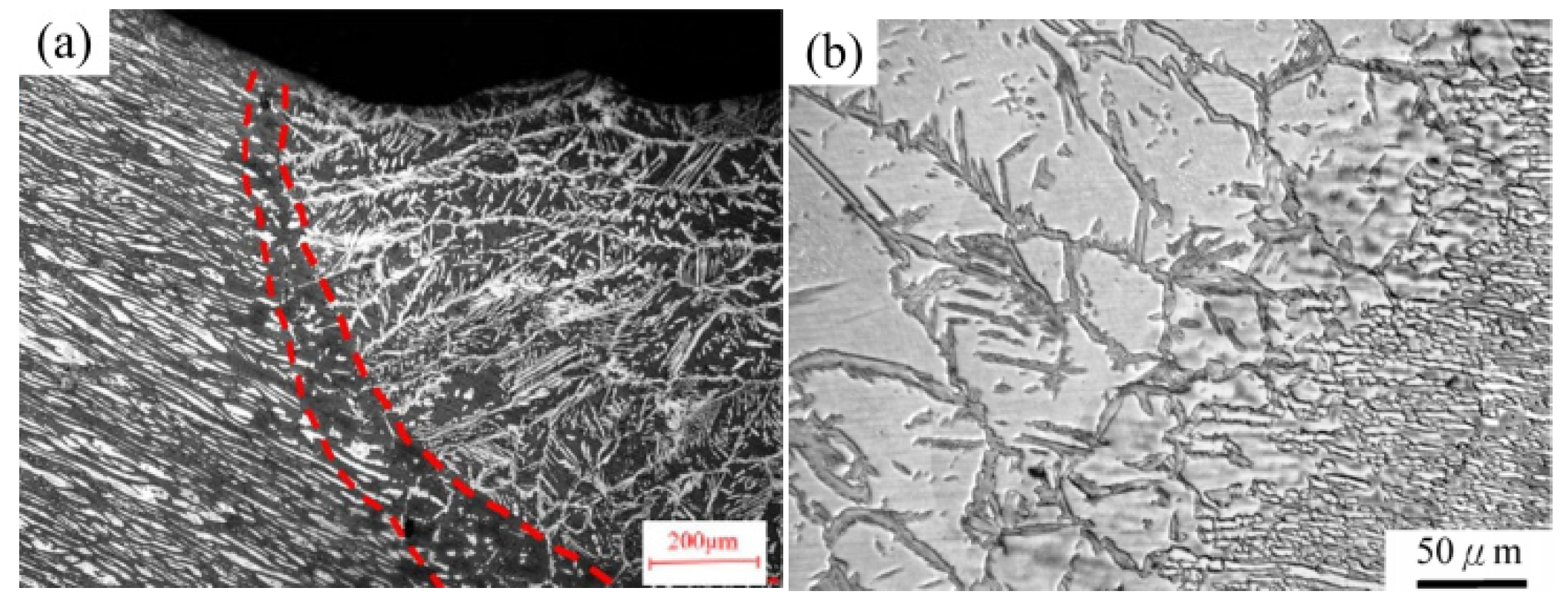

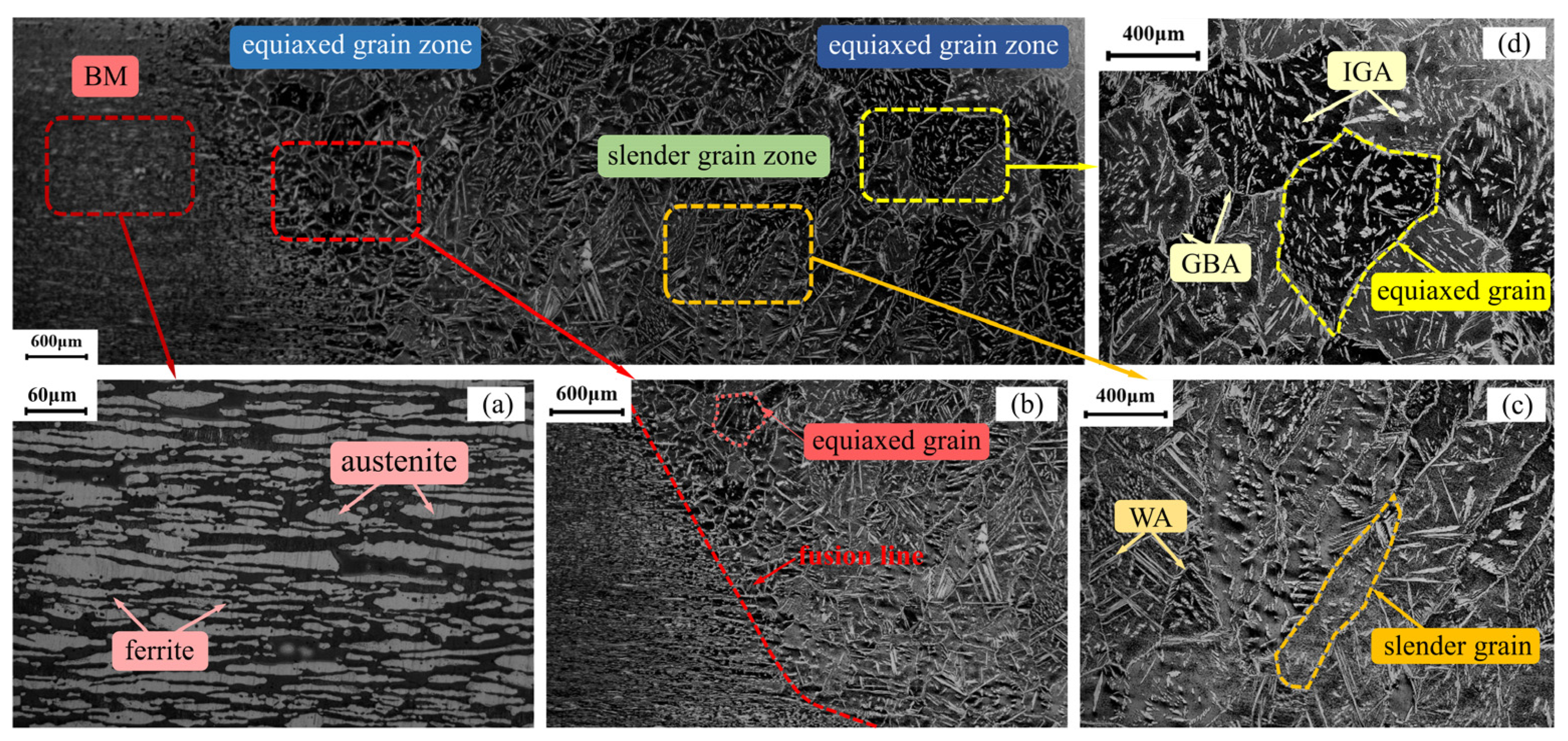
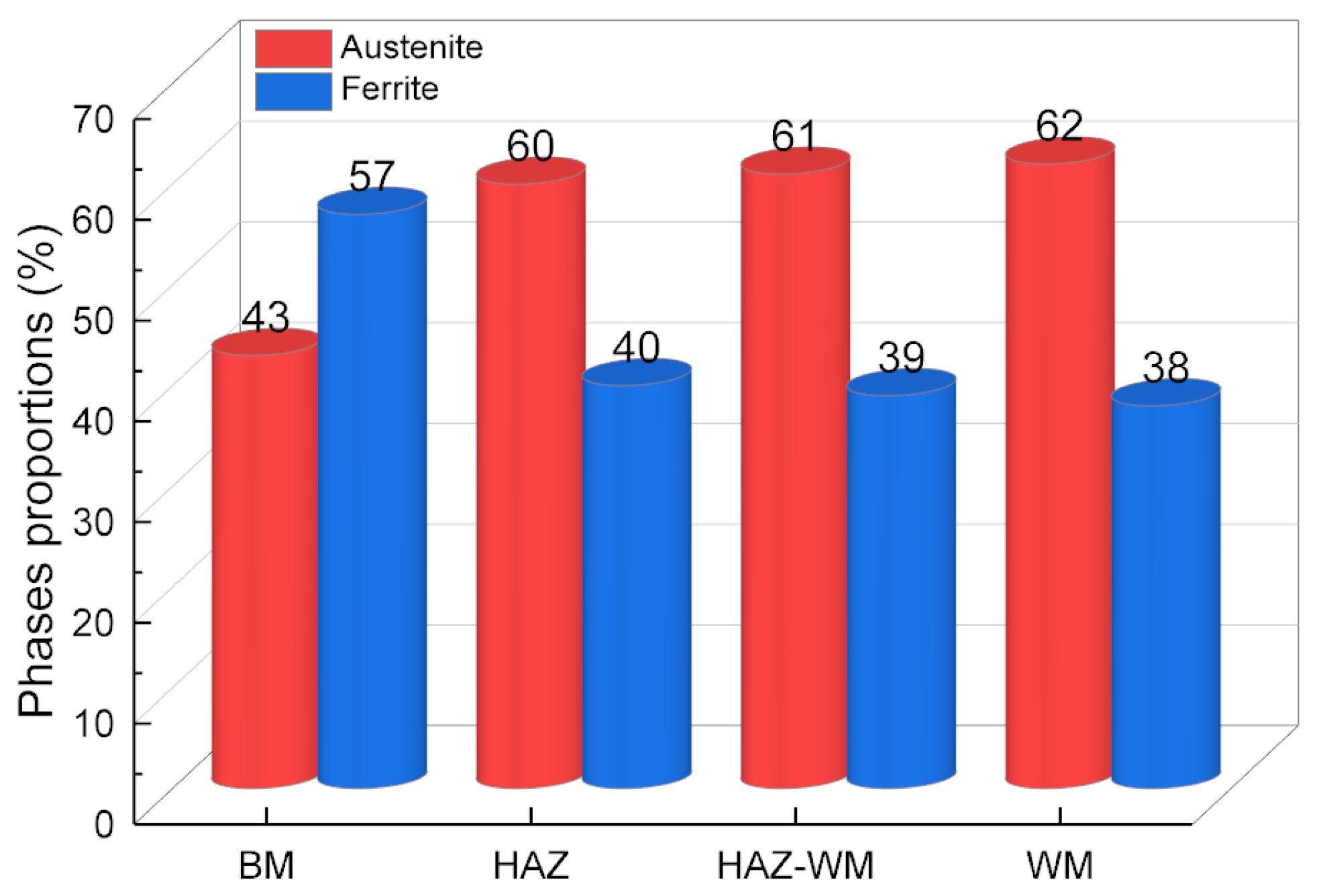

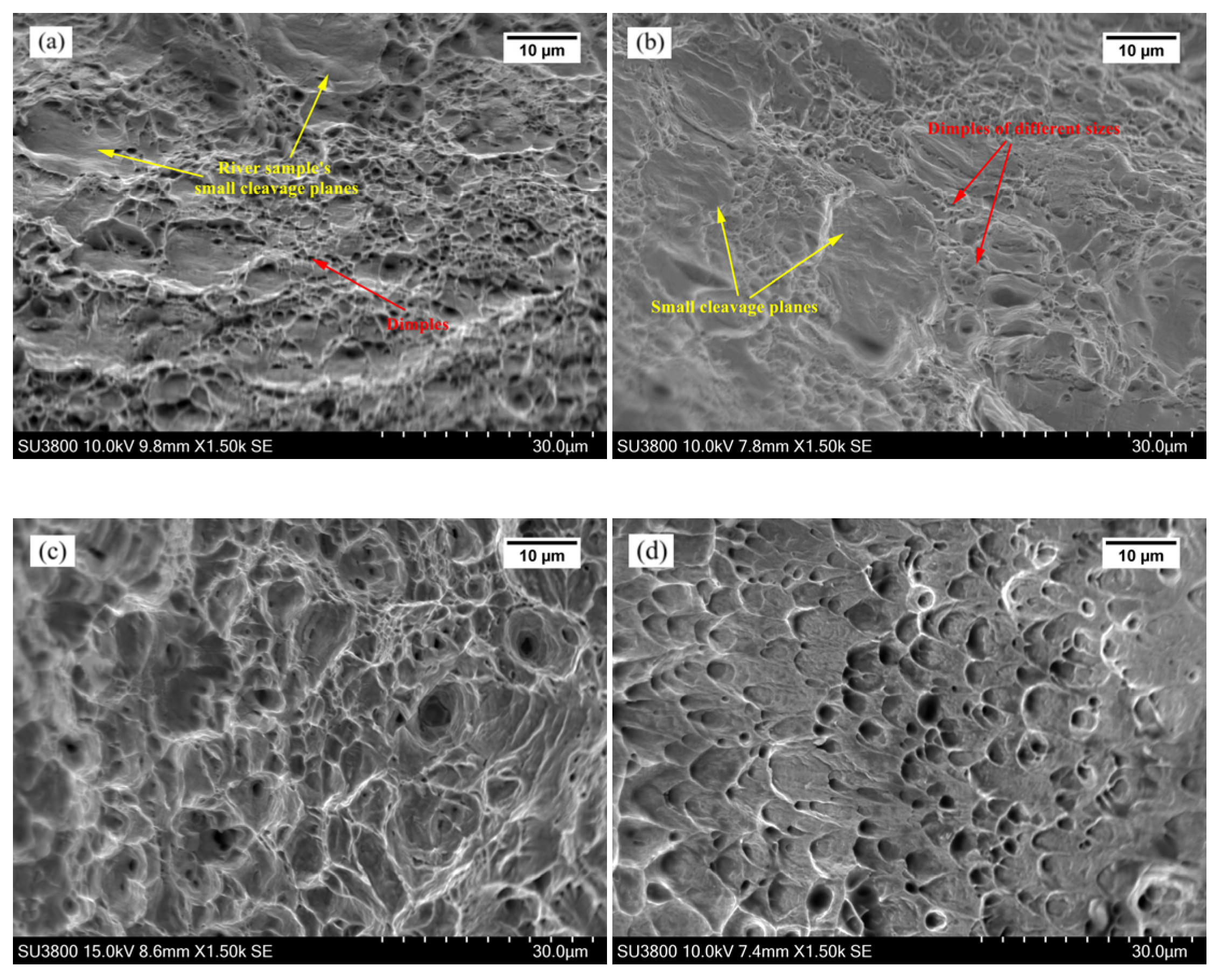

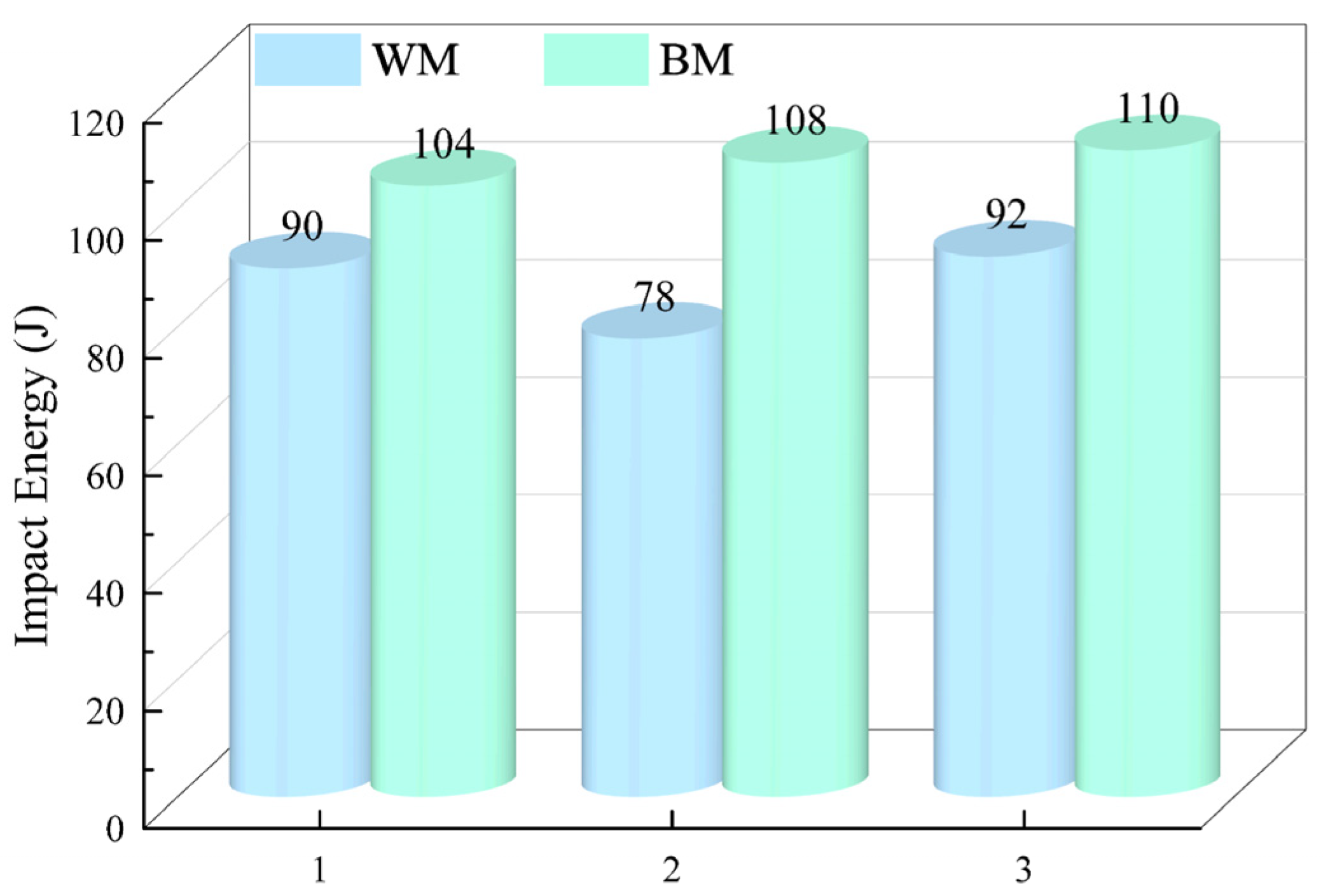
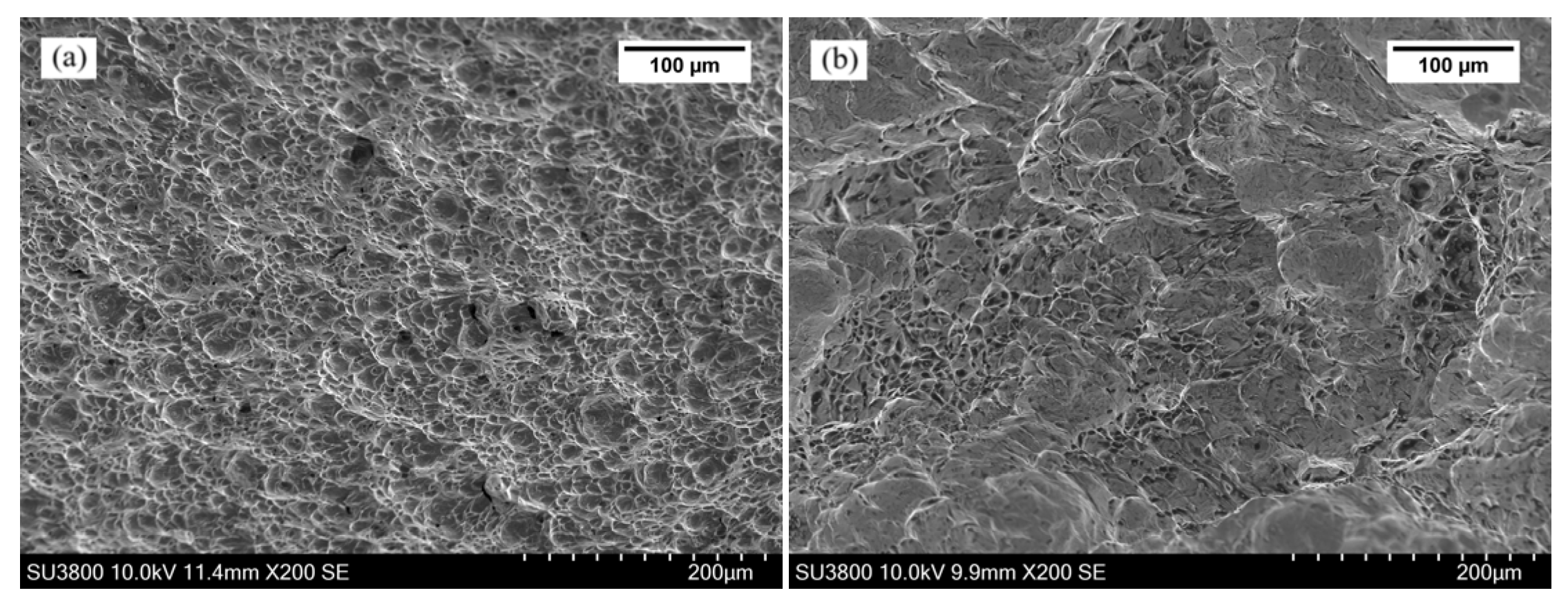

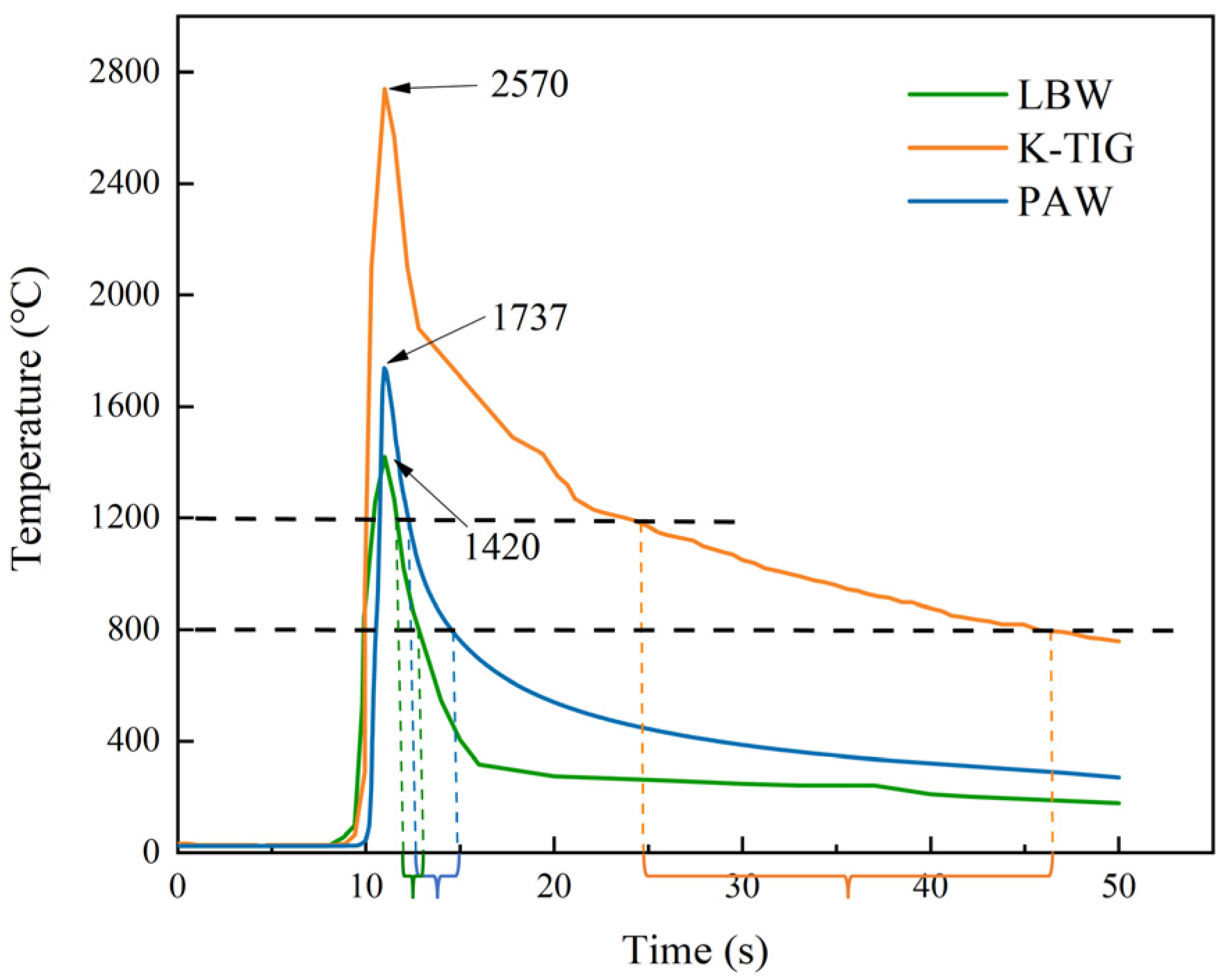
| C | Si | Mn | P | S | Cr | Ni | Mo | N | Fe | |
|---|---|---|---|---|---|---|---|---|---|---|
| SAF2205 | 0.02 | 0.6 | 1.5 | 0.03 | 0.001 | 22.5 | 5.8 | 3.0 | 0.16 | Rest |
| ER2209 | 0.023 | 0.46 | 1.74 | 0.022 | 0.01 | 22.95 | 8.79 | 3.1 | 0.17 | Rest |
| Current (A) | Voltage (V) | Welding Speed (mm/min) | Filler Metal and Protective Gas | Heat Provided (J/mm) |
|---|---|---|---|---|
| 210 | 35.75 | 390 | ER2209 + argon | 3554 |
Disclaimer/Publisher’s Note: The statements, opinions and data contained in all publications are solely those of the individual author(s) and contributor(s) and not of MDPI and/or the editor(s). MDPI and/or the editor(s) disclaim responsibility for any injury to people or property resulting from any ideas, methods, instructions or products referred to in the content. |
© 2024 by the authors. Licensee MDPI, Basel, Switzerland. This article is an open access article distributed under the terms and conditions of the Creative Commons Attribution (CC BY) license (https://creativecommons.org/licenses/by/4.0/).
Share and Cite
Hu, X.; Qin, L.; Wang, H.; Zhang, L.; Xie, X. Microstructure Formation and Its Effect on Mechanical Properties for Duplex Stainless Steel 2205 Plasma Arc Welded Joint. Metals 2024, 14, 68. https://doi.org/10.3390/met14010068
Hu X, Qin L, Wang H, Zhang L, Xie X. Microstructure Formation and Its Effect on Mechanical Properties for Duplex Stainless Steel 2205 Plasma Arc Welded Joint. Metals. 2024; 14(1):68. https://doi.org/10.3390/met14010068
Chicago/Turabian StyleHu, Xiaodong, Lu Qin, Huanqing Wang, Lu Zhang, and Xuefang Xie. 2024. "Microstructure Formation and Its Effect on Mechanical Properties for Duplex Stainless Steel 2205 Plasma Arc Welded Joint" Metals 14, no. 1: 68. https://doi.org/10.3390/met14010068





